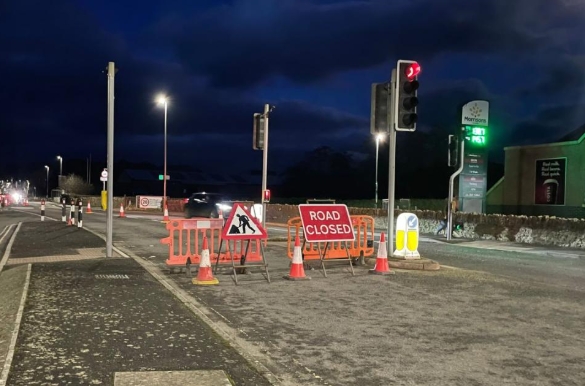
The Department of Energy’s Grid Deployment Office on May 10 issued a joint notice of information (NOI) and a request for information (RFI) seeking stakeholder input on how it could structure the TFP, a “revolving fund” program that will provide federal support to developers of large-scale new transmission lines or upgrades of existing lines. The fund will also cover the connection of microgrids in select states and U.S. territories.
The initiative is a key attribute of the Biden administration’s ambitions to achieve a “carbon-free” electric grid by 2035 and a net-zero emissions economy by 2050. “As part of the [IIJA] implementation, DOE is authorized to borrow from the Treasury, without further appropriation and without fiscal year limitation, up to $2.5 billion in outstanding repayable balances at any one time for the purpose of carrying out the TFP,” the agency said on Tuesday. “The expansion of transmission infrastructure facilitated by the TFP lays the groundwork for increasing the availability of lower cost and low carbon electricity sources.”
Three Forms of Line-Building ‘Facilitation’
The DOE expects the TFP will offer three forms of “facilitation” that could bolster the construction of new, replacement, and upgraded high-capacity transmission lines: capacity contracts, loans, and public-private partnerships.
Under the TFP, the DOE anticipates purchasing the right to use transmission capacity of up to 50% of an eligible project’s total proposed transmission capacity for a term-limited to 40 years. The measure is designed to help “provide certainty to developers, operators, and marketers that customer revenue will be sufficient to justify the construction of a transmission line that meets current and future needs.” Applications for capacity contracts will not be required to account for National Environmental Policy Act (NEPA) environmental impact review, “because DOE’s entry into a capacity contract does not independently trigger NEPA review,” the DOE noted. However, the agency said it could terminate a capacity contract if it determines sufficient subscription to the new project to ensure its “long-term financial viability” or offer its contractual rights to a third party.
The DOE also anticipates a “TFP loan” process that would echo a process the DOE currently uses to evaluate loans and loan guarantees offered by the Loan Programs Office or federal Power Marketing Administrations. It said, meanwhile, that it anticipates TFP public-private partnerships will be similar in structure and process to transmission projects the agency already spearheads through the Southwestern Power Administration or the Western Area Power Administration—“except that DOE has funding available under the TFP to invest in an eligible project.”
The IIJA, however, directs the Energy Secretary to prioritize projects that will improve resilience and reliability of the grid, facilitate inter-regional transfer of power, lower power sector greenhouse gas (GHG) emissions, and use technology that enhances the “capacity, efficiency, resilience, or reliability of the transmission system.” The TFP must “judiciously use the tools included in the statute to support projects that both meet the statute’s articulated goals and provide a reasonable expectation that the costs of capacity contracts, loans, or public-private partnerships borne by the Federal Government will be repaid,” the DOE noted.
In its joint NOI and RFI, the DOE on Tuesday underscored that the IIJA requires eligible electric power transmission lines must be capable of transmitting at least 1 GW. Projects that consist of upgrading existing transmission lines or building new lines in an existing transmission, transportation, or telecommunications infrastructure corridor should be at least 500 MW.
First Projects Must Be Operational by December 2027
The agency’s proposed timeframe for TFP rollout suggests it is aiming for the first set of capacity contract projects to begin commercial operation by at least Dec. 31, 2027. The first TFP solicitation, limited to capacity contracts, will likely be issued this year (2022), and a second solicitation, which will cover capacity contracts as well as loans, and public-private partnerships, is expected in early 2023. “Following the second solicitation, the types and amounts of TFP support offered in 2024 and beyond will be identified in the solicitation documentation,” it said.
According to the Energy Information Administration, the U.S. bulk power system in 2019 comprised 22,731 electric generators at about 10,346 utility-scale electric power plants. Once generated, their power is delivered over more than 600,00 circuit miles of transmission lines, including 240,000 that are considered high-voltage. Another 5.5 million miles of local distribution lines carry power to their final destination. Most of the grid is privately owned: Around 72% of U.S. power customers are served by for-profit investor-owned utilities, while rural cooperatives serve the rest. Federal and state agencies have regulatory authority over generation and transmission systems, while customer rates are generally regulated by state and local agencies.
Owing to this complexity, just how old the currently operational transmission system is is hard to pinpoint. The DOE in its 2015 Quadrennial Technical Review quoted a 2005 report that suggested about 70% of the grid’s transmission lines and power transformers were at least 25 years old, and 60% of circuit breakers were 30 years or older—but the 2005 figure has been repeatedly quoted in official documents to describe the transmission system’s aging assets.
The DOE cited the same figure again on Tuesday to underscore the grid’s age and vulnerabilities. It added, however, that “independent estimates” indicate that the U.S. will need to expand electricity transmission systems by 60% by 2030, and may need to triple it by 2050 to meet the country’s increase in renewable generation and expanding electrification needs.
“Power outages from severe weather have doubled over the past two decades across the United States and the frequency and length of power failures reached their highest levels since reliability tracking began in 2013—with U.S. customers on average experiencing more than eight hours of outages in 2020,” it said.







